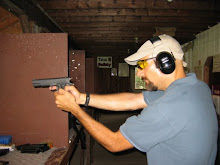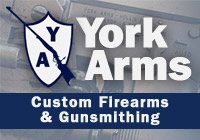Shotgun gauges are significantly easier to describe for the new shooter, as there are dramatically fewer choices available for smoothbore weapons. Since the projectiles are so similar, there's been less specialization in the shotgun world over the years. The largest gauges have fallen out of favor, as have some of the less common ones, but the venerable 12 gauge - which started life as a black powder weapon.
"Gauge" is somewhat confusing unit of measure - it's the only one that decreases as the overall size increases. This is because "gauge" refers to the number of lead balls of that diameter which are needed to make one pound. A 10 gauge, therefore, would require 10 lead balls at that diameter (0.78") to make one pound, a 12 gauge 12 lead balls (at 0.73") and so forth down the line. The only shotgun offering that's not really a gauge at all (although it is often called a gauge) is the diminutive .410 bore made popular recently with the advent of the Taurus Judge.
Gauge Sizes. Currently there are only six different sizes of shotguns available: 10 gauge, 12 gauge, 16 gauge, 20 gauge, 28 gauge, and .410 bore. 8 gauge, 32 gauge, and 36 gauge shotguns have been offered, but have fallen by the wayside in recent years. Realistically, 12 gauge, 20 gauge, and .410 bore are the three shotgun offerings most likely to be found on the shelves of the standard gun shop. 10, 16, and 28 gauge are still produced, but will take some digging to produce and will be significantly more expensive.
Types of shot. There are three standard types of shotgun projectiles: Slugs, birdshot, and buckshot. Slugs can be rifled - to be shot out of smooth barrels - or not (sabot slugs) - to be shot out of rifled barrels. Buckshot comes in sizes from 0000 (0.38", roughly five pellets per 12 gauge shell) to #4 (0.24", 21 pellets to a 12 gauge shell). Birdshot gets even more complex, with a wide range of shot sizes depending on the type of game hunted and the distance at which the game will be shot. Birdshot is also used to shoot clay "pigeons" for trap or skeet shooting.
Chokes. With birdshot used for hunting or sporting applications, it's common to use a choke to restrict or otherwise direct the shot in a certain manner. "Cylinder" (no choke) is the lowest, with a useful range of approximately 20 yards, followed by a "skeet" choke which adds a few more. Modified and then Full round out the chokes, with different permutations of each choke allowing greater distance from the particular choice of shot. In all cases, with even the tightest choke the functional distance is less than 50 yards as a rule.
Chamber. Another way to get more power out of a shotgun round is to make the round longer and put in more powder. The standard size for a 12 gauge shell is 2 3/4, with a "Magnum" round having a 3" chamber and newer shotguns available with up to a 3½" chamber. It's important to select the proper shell for your shotgun - a 2 3/4" shell in a 3½" chamber will be inherently inaccurate (and, obviously, the reverse plain won't fit...)
Miscellany.
- Shotguns have numerous less-than-lethal rounds available, from rubber slugs to plastic shot to pepper balls. It's gone far beyond the ol' rocksalt load!
- It's not advisable to use a saboted slug in a smoothbore barrel or a rifled slug in a rifled barrel.
- Steel shot is quite often dangerous to use in an older shotgun because of the increased density of steel over lead and older barrels and chokes.
- Signal flares, flechettes, and even "flamethrower" rounds (Dragon's Breath) are available but not advisable - some are even harmful to your shotgun's barrel.
Thus concludes our introduction to shotgun gauges and rounds. It also brings our "100" series of introductory posts on different calibers and gauges to a close. This series was designed with the new shooter in mind to give a rough overview of the different options available. I've carefully avoided offering my opinion in any of these posts for fear of influencing folks in one direction or another - no need to pass my mistakes and prejudices on!
Let me know if I missed anything in the shotgun overview - or if there's another avenue we can explore.
That is all.







13 comments:
These last few post on calibers and gauge have been great, so I am only answering the last question because you asked.
Types of shotguns wasn't mentioned. I can think of pump; break-open in single barrel, side-by-side and over-and-under; (semi)automatics in both recoil and gas operated; bolt action; and magazine fed. There might be another post discussing this.
Wait, wait wait...
There is a type of slug ammo I can buy for my smoothbore shotgun that will make my projectile spin as if coming out rifled barrel? This is new to me, and I want you to tell me more. Cuz that would be very cool.
One issue with chamber/shell sizes:
It is perfectly fine to fire a 2 3/4" shell in a 3" chamber. It may affect the shot pattern to some degree, but to say that it will "reduce accuracy" is inaccurate (no pun intended).
The more important point is that you are incorrect that 3" shells won't fit in a 2 3/4" chamber. They absolutely will fit. The problem is that the forcing cone will be too close to the crimp end of the shell. When the shotgun fires, the crimp won't be able to open all the way, blocking the bore and causing a dangerous overpressure in the chamber which can result in a kaboom.
Just because the shell fits in the chamber DO NOT assume that it is safe to fire. Always check the chamber length stamped on the barrel to verify that it is cut for the ammunition you are using.
I’ve never noticed a difference in accuracy when shooting 2-¾ out of my 3-½ inch chamber? Are you talking slugs? Birdshot doesn’t seem to care.
"Steel shot is quite often dangerous to use in an older shotgun because of the increased density of steel over lead and older barrels and chokes."
Huh? Lead is considerably denser than steel... or are you referring to something other than the density of the material?
You missed a few choke tube sizes.
Cylinder
Skeet 1
IC (Improved Cylinder)
Skeet 2
Modified
IM (Improved modified)
Full
Extra Full (sometimes called Improved Full)
Turkey
Each level up from cylinder adds another .005" of constriction.
And Ross is right about steel being less dense than lead. The danger with older barrels isn't really a pressure issue. All shotguns run at 12,000psi or lower. It's been that way for at least a hundred years.
ASM826,
Thanks! I was focusing on the ammunition used as per the initial request, hence why I didn't get into action type in any detail.
Hmmm. Would be an interesting series... ;)
T-bolt,
Brenneke-type slugs have been around for a while. I've only shot them at "conversational" distances, but they're often used by hunters for 50 - 100 yard shooting.
Sailorcurt,
Thanks for the tip - I'm so OCD that I've never ever tried to fit a 3" shell in a 2 3/4" chamber.
RipRip,
I've never noticed much difference either - but then again the only shotgun I've ever swapped shell-sizes in is my Saiga-20, so I'm not sure what "accuracy" would be affected... :)
Ross,
Wrong choice of words on my part - steel is harder than lead, not denser.
Justin,
Once again, this is meant as an overview - just to give a quick snapshot of what's out there for shotgun ammo.
I meant hardness, not density for why not to use steel shot in older shotguns. Once again, wrong choice of words...
Jay, If I could add a bit more on chokes, the Turkey and there is an extended Super Turkey that is straight rifled to stabilize the shot column as it comes out the end of the barrel and you can get standard twist rifled chokes to shoot sabot slugs in a smooth barrel.
Not confuse matters even more, there are ported extended chokes that act as a minimal muzzle break as well.
Problem with steel shot as you pointed out is the hardness but the reason that is an issue with pressures is not so much peak chamber pressure when the shot is fired. It is when the shot column reaches the choke. If you are using a full choke and shoot steel through it, the lead (softer and more malleable) will deform more easily as it passes through the choke. The steel will not deform and can cause a second pressure spike in the barrel as it passes through the choke. Same reason to NEVER fire slugs through more than a modified choke. Most of the time you can get away with it but I have witnessed a Turkey gun trashed by guy shooting a slug through it that took the choke downrange with it as it passed through the end of the barrel. Effectively ruining the barrel. The slug passed through the choke and went on it's merry way and the choke came to rest about 5 yards in front of the shooter. It was not pretty.
Only comment I'd throw in would be about grandpa's shotgun.
Many many many old shotgund were designed to be fired with black powder loads and are unsafe with any ammo that has been made in the past few decades. Antiques should be thoroughly investigated before taking them to the range.
a 12ga 2 1/2" chamber would indicate black powder only, 2 3/4" or longer would be smokeless.
Most of the older shotguns will have Damascus barrels which are not designed for use with smokeless powder.
I don't own any right now, but don't the Remington Slugger slugs say on the box that they should be used with full choke for best results?
I Liked this.
I would have added a "speaking" guide.
You'd get a strange look if you asked for some zero zero buckshot. Double-ought works better (at least here in Idaho).
Isn't it funny that the oldest and most simple personal firearm can be the most confusing to a noob?
I think many folks would appreciate a greater expansion on ASM826's ideas...not to mention chokes, and the various shotgun loads and purposes thereof.
Post a Comment